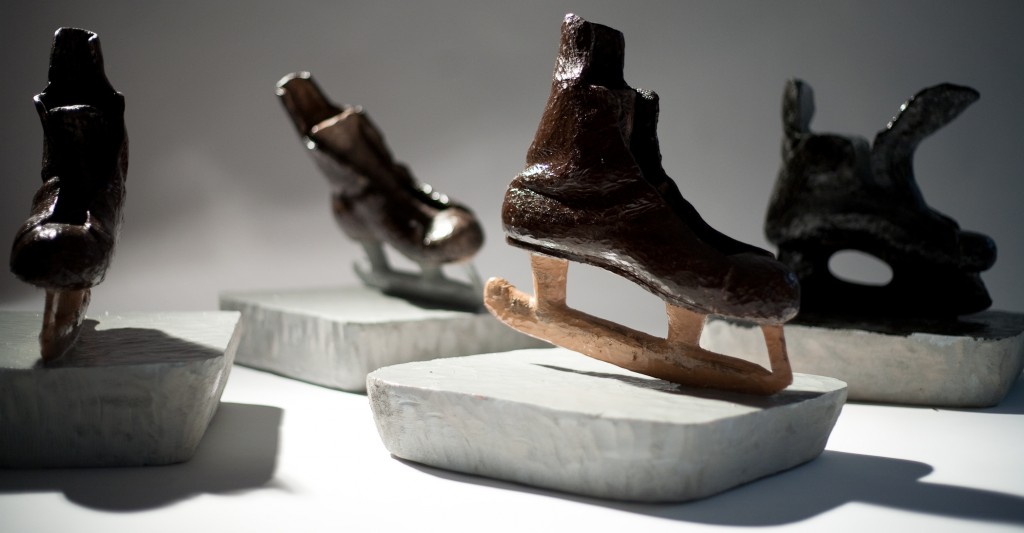by Skye Priestley
Duncan Hewitt: Turning Strange is the Portland Museum of Art’s latest foray into the contemporary. The exhibition contains work made by Hewitt over the last twenty years and provides an excellent opportunity to see a large body of work by an influential Maine sculptor. While Hewitt’s art is diverse, a series of representative traits may be found running through the exhibition. That is, any investigation of Hewitt’s work tends to be drawn to three distinct objects of inquiry: the formal properties of the work, the autobiographical properties of the work, and, finally and most crucially, the constant presence a sense of both ambiguity and liminality, particularly in regards to the process of creation.
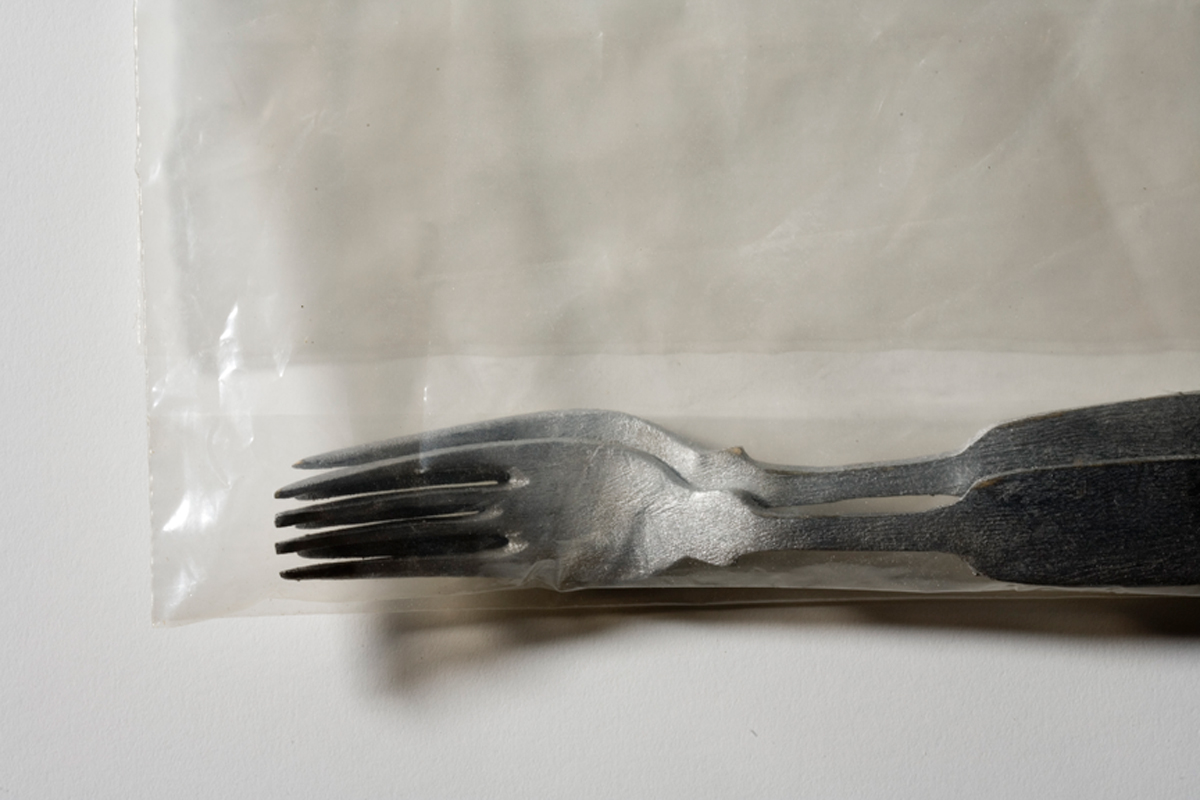
Hewitt generally chooses to make wood sculptures of the mundane objects of daily life: skates, cushions, sleeping mats, pot lids, and other similar objects. Some of these pieces are not so different in concept from the work of Franklin Simmons, whose 19th century marble and bronze sculptures of classical figures stand in a different wing of the museum. This is sculpture as mimesis. But there are crucial differences, primarily that while Simmons’ work belongs to a long running tradition of classical sculpture, Hewitt’s work only owes allegiance to its own principles, which vary throughout the exhibition. The stacked sleeping mats are even more lifelike than classical sculpture, mostly because they have been painted. Yet the fire screens that Hewitt has carved, and which stand in the McClellan house beside the screens from which they have been copied, are obvious fakes. No sculptor can carve wood into a fine metal mesh, no matter how skillful. Here mimesis is neither possible nor desired.
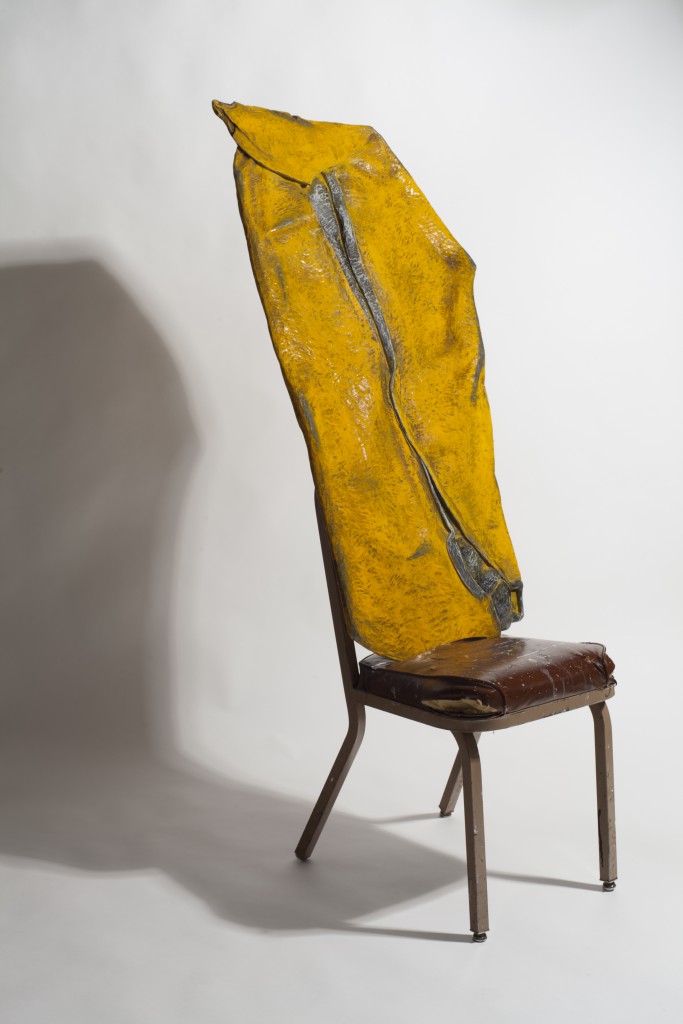
The point is an obvious but important one: each artwork must be judged by a set of standards peculiar to itself. Indeed, one of the most delightful aspects of the exhibition is how willing Hewitt is to change the end goal of his artistic process. This not only provides the viewer with a broad variety of possible definitions for what a sculpture can be, it also shifts the emphasis of the exhibition as a whole away from preoccupations with mimetic accuracy and towards an understanding of the process of creation itself. Two excellent examples of this are Silver Smashup and Yellow Smashup, both from 2012. In these works Hewitt has taken small pot lids, hammered and folded the metal, and then reproduced them at a large scale in wood. As a result, unlike nearly every other work in the exhibition, these two pieces lose any identifiable character and become studies in form. Lest they lapse too far into a modernist purity, Hewitt has positioned the works on found objects: a chair and a stool. These readymade pedestals create one of the liminal tensions that Hewitt is most fond of treading, the thin line between object and sculpture.
No visitor to Turning Strange will be able to avoid the dense autobiographical references that pervade the work. A reproduction of a wading pool recalls the pool in which Hewitt’s children played. Skates come from his career as a hockey player. Large sculptures of Long Island, Hewitt’s childhood home, sit heavily on chairs, splaying out into the space around them. Even the titles cannot avoid personal reference. Yet the experience of the work is not personal, any more than a symphony written on the basis of an event in the life of its composer is personal to its listener. While these objects may have personal significance for Hewitt himself, that autobiographical logic, the reasons why they have surfaced in Hewitt’s work, is largely not available to the viewer.
In a recent issue of ArtForum, the art historian and critic Claire Bishop wrote concerning the work of the artist Dan Vo, whose work also deals extensively with autobiography:
The nuggets of evidence Vo deploys in his own work aren’t exactly gratuitous, but they do privilege the biographical … Vo’s art … [is] based on an introversion that labors to keep meaning withheld from the viewer, and as such unchallengeable—as the saying goes, you can’t argue with taste. … The result is an ambience that you just kind of feel rather than understand. The artist’s recourse to his own experience gives the work a frisson of historical significance, but this is ultimately grounded in biography and sensibility, two authority-granting aspects of the author-function that have long been criticized as regressive.1
It is certainly true that the opaque nature of the organizational logic of Turning Strange yields a show that is felt rather than understood. Yet, if we take biography and sensibility out of art entirely, what are we left with? Myth and form? In removing the “regressive” we regress to the classical. Perhaps more importantly, how does a culture decide what subjects are worth making art about? It may be the anti-democratic nature of work based on autobiography that makes it particularly vulnerable to being criticized as trivial.
There is an abundance of historical examples in which the self has proven to be a vital trove of material for artistic experimentation (Proust, Rembrandt) and just as many in which self-study has lapsed into narcissism and triviality. (Kim Kardashian’s book, Selfish, comes to mind.) Hewitt’s work fits somewhere in the middle. Pieces such as Window (which I awake to) feel like considerations of memory itself. Elsewhere, the outline of Long Island provides a simple source for a complicated shape that smoothly integrates into Hewitt’s formal language. On the other hand, My Hat Kisses Hers, a carving of a mask kissing a hat, fails to integrate into the work that surrounds it, becoming a somewhat awkward and inaccessible memento. The catalogue suggests that Hewitt’s sculpture “invites us to attach our own meanings”2, but in this case it seems difficult to escape the original subject matter.
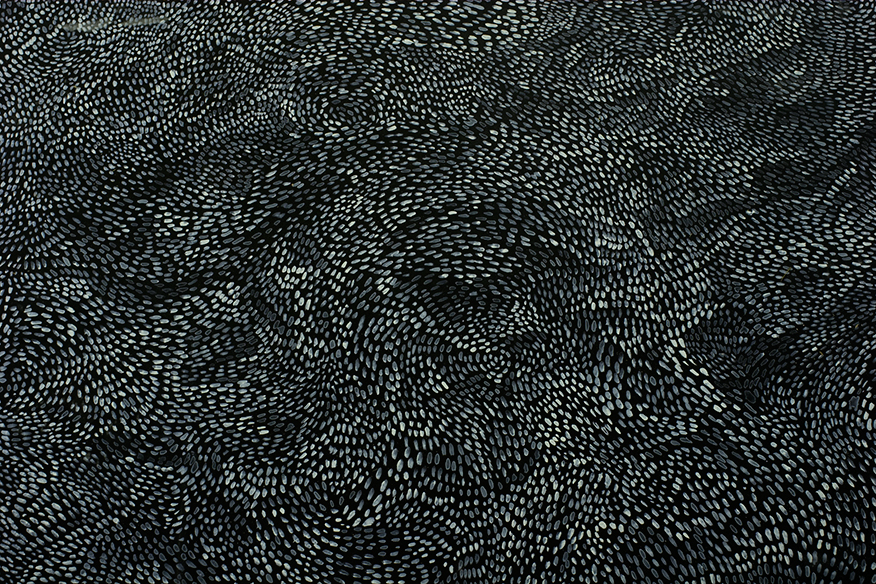
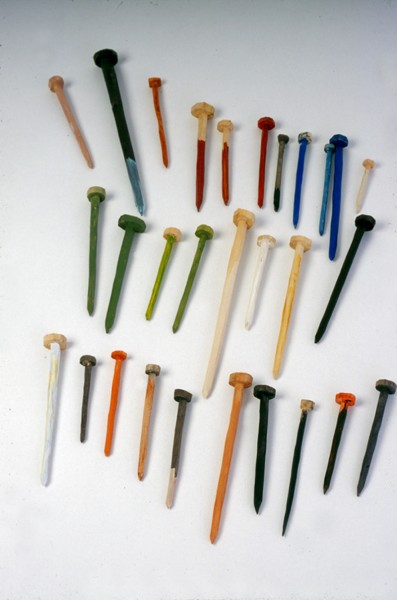
A more significant criticism of Hewitt’s work lies in its failure to meet its own standards. For example, of the 28 works in this show, only one is not made out of wood. Pool, from 2005, easily the largest work in the show, and the only work that might validate the description of Hewitt’s work as “monumental” in the wall text, is made out of rubber. This is a puzzling aporia, especially considering that the most obvious reason for it, the difficulty of the task, is also the least valid. Other choices are equally confusing. We can only guess why the masks, which have seem serious in their anonymity, have been made up with bright red lips and green eye sockets. Or why the extraordinary accuracy of the carving seems to give way to rough approximation in Colored Test (29 nails).
There are triumphs as well. Even knowing that the works are made out of wood ahead of time, I found myself mistaking Porch Screen for the real thing. Upon approaching and realizing that it was a sculpture, with a screen whose delicate waves have been painstakingly reproduced, it was hard not to feel a tinge of delight, not only at the excellence of the carving, but also at the simultaneous banality and liveliness of the sculpture itself, which hangs in such a pedestrian way and yet conceals a marvelous secret.
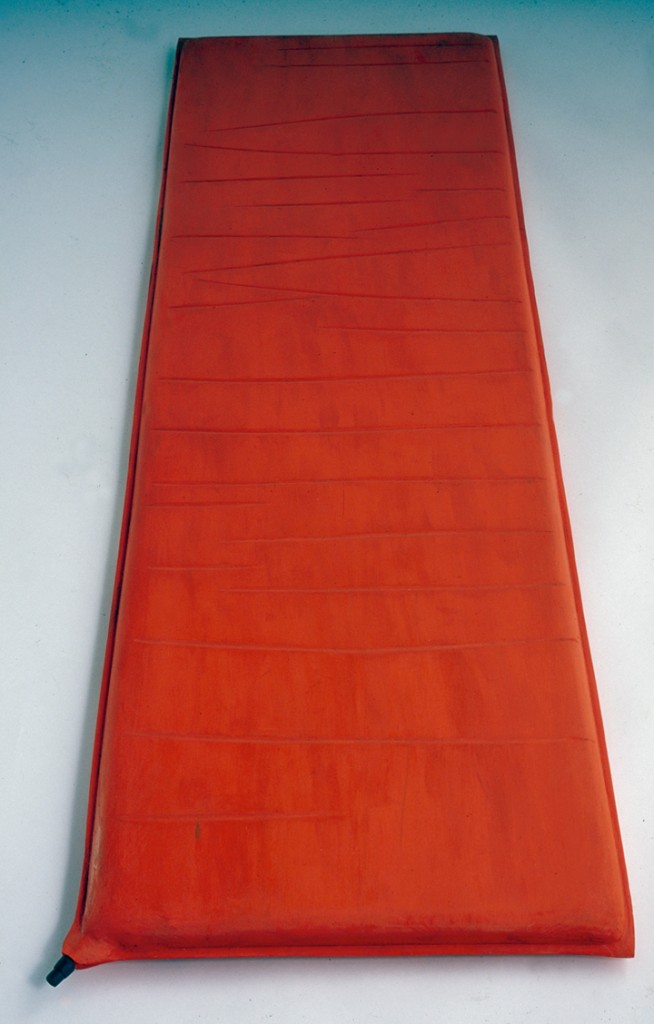
The hockey skates, another example of works with a personal meaning that shine strongly as formal objects, do not manage the mimetic trick. The wooden blades on which they rest do not have the strength of their steel source objects, and so must compensate with an uncharacteristic thickness. This in no way detracts from the excellence of the art.3 There is a willful sincerity to these skates, Hewitt’s most practiced gesture, in which the fidelity of the act of copying cedes to an almost arbitrary final treatment. Paint dribbles, laces bunch, and edges are defined with an airy lack of certainty. Having taken the sculpture as far as it will go, Hewitt softens his touch, crafting human objects that feel not delicate but vulnerable, capable of error, and ultimately whole exactly because they are imperfect.
Nearly all of the work in Turning Strange contain a characteristic ambiguity, a resistance to actualization, which is both its greatest strength and weakness. There is a tendency, in both artists and viewers, to treat artworks as the reification of the absolute conceptions we contain within our minds, and to demand, for instance, that the mimetic work reproduce the object exactly, that the framing be executed without error, and that the patina be applied evenly. To apply this treatment universally would mean the reinstitution of classical standards; it is a conceptual dead end for art. It is within the space of negotiation, in which the object itself gains a voice in the process of creation and is allowed to upend conventional systems of thought surrounding the concepts of value and quality, that all true art arises. Hewitt’s own thoughts on his process of creation run along similar lines. He describes patterns of emotional push and pull and an interrogation of the liminal spaces of creation:
[For many years]… the notion that I would move towards an object directly is like, “No way am I doing that,” so when I do it, it’s not about reproducing the piece at all, it’s about exploring its space. And I immediately start making decisions, “No, I’m not going to do this, I’m going to do that,” but I’m also trying to honor its existence. I’m not going to say it’s objective versus subjective because I think it’s more complicated than that. … I have a poem on the wall by Kay Ryan, which I love, and basically she’s saying “I know these things mean something but I forget what they mean,” and I like that, you know, that we have that sort of sense that these relationships mean something, but then it slips away from you. 4
Duncan Hewitt: Turning Strange is on view at the Portland Museum of Art through September 4, 2016.
Portland Museum of Art
7 Congress Square, Portland, Maine | 207.775.6148
Open Tuesday, Wednesday, Saturday, and Sunday 10am–5pm, Friday 10am–9pm, Third Thursdays 10am–8pm. $12 adults, $10 seniors and students, $6 youth 13–17, $5 surcharge for special exhibitions. Free for children under 12, members, and everyone on Friday evenings 5pm–9pm.
- Claire Bishop, “History Depletes Itself,” ArtForum, September, 2015, 325. ↩
- Duncan Hewitt: Turning Strange, Portland: Portland Museum of Art, 2016. (pamphlet) ↩
- “As Alban Berg said, it is a prosaic matter to make sure that the work shows no nails sticking out and that the glue does not stink”, Theodore W. Adorno, Aesthetic Theory, ed. Gretel Adorno and Rolf Tiedemann, trans. Robert Hullot-Kentor (Minneapolis: University of Minnesota Press, 1997), 14. ↩
- Duncan Hewitt. Interview by author. Recording. Portland, Maine, January 15th, 2016 ↩
Skye Priestley is an artist, poet and critic living in Portland. He likes to play soccer and ride his bike. You can find some of his writing and artwork at sjpriest.wordpress.com.

